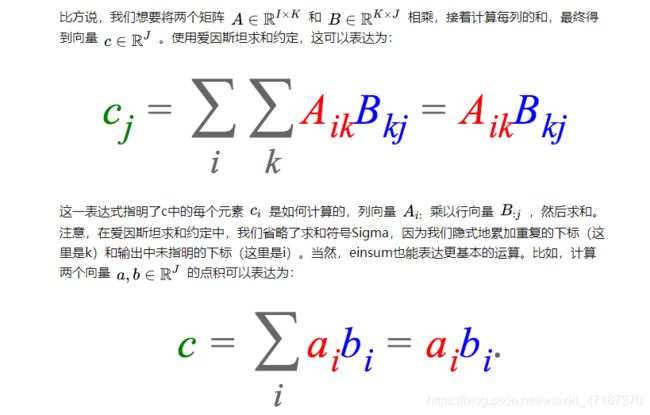einsum满足你一切需要:深度学习中的爱因斯坦求和约定
作者:Tim Rocktäschel
编译:weakish
【编者按】FAIR研究科学家Tim Rocktäschel简要介绍了einsum表示法的概念,并通过真实例子展示了einsum的表达力。
当我和同事聊天的时候,我意识到不是所有人都了解einsum,我开发深度学习模型时最喜欢的函数。本文打算改变这一现状,让所有人都了解它!爱因斯坦求和约定(einsum)在numpy和TensorFlow之类的深度学习库中都有实现,感谢Thomas Viehmann,最近PyTorch也实现了这一函数。关于einsum的背景知识,我推荐阅读Olexa Bilaniuk的numpy的爱因斯坦求和约定以及Alex Riley的einsum基本指南。这两篇文章介绍了numpy中的einsum,我的这篇文章则将演示在编写优雅的PyTorch/TensorFlow模型时,einsum是多么有用(我将使用PyTorch作为例子,不过很容易就可以翻译到TensorFlow)。
1.einsum记法
如果你像我一样,发现记住PyTorch/TensorFlow中那些计算点积、外积、转置、矩阵-向量乘法、矩阵-矩阵乘法的函数名字和签名很费劲,那么einsum记法就是我们的救星。einsum记法是一个表达以上这些运算,包括复杂张量运算在内的优雅方式,基本上,可以把einsum看成一种领域特定语言。一旦你理解并能利用einsum,除了不用记忆和频繁查找特定库函数这个好处以外,你还能够更迅速地编写更加紧凑、高效的代码。而不使用einsum的时候,容易出现引入不必要的张量变形或转置运算,以及可以省略的中间张量的现象。此外,einsum这样的领域特定语言有时可以编译到高性能代码,事实上,PyTorch最近引入的能够自动生成GPU代码并为特定输入尺寸自动调整代码的张量理解(Tensor Comprehensions)就基于类似einsum的领域特定语言。此外,可以使用opt einsum和tf einsum opt这样的项目优化einsum表达式的构造顺序。

在深度学习中,我经常碰到的一个问题是,变换高阶张量到向量。例如,我可能有一个张量,其中包含一个batch中的N个训练样本,每个样本是一个长度为T的K维词向量序列,我想把词向量投影到一个不同的维度Q。如果将这个张量记作 [公式] ,将投影矩阵记作 [公式] ,那么所需计算可以用einsum表达为:

2. Numpy、PyTorch、TensorFlow中的einsum
einsum在numpy中实现为np.einsum,在PyTorch中实现为torch.einsum,在TensorFlow中实现为tf.einsum,均使用一致的签名einsum(equation, operands),其中equation是表示爱因斯坦求和约定的字符串,而operands则是张量序列(在numpy和TensorFlow中是变长参数列表,而在PyTorch中是列表)。例如,我们的第一个例子,cj = ∑i∑kAikBkj写成equation字符串就是ik,kj -> j。注意这里(i, j, k)的命名是任意的,但需要一致。
PyTorch和TensorFlow像numpy支持einsum的好处之一是einsum可以用于神经网络架构的任意计算图,并且可以反向传播。典型的einsum调用格式如下:
import torch
a = torch.arange(6).reshape(2, 3)
torch.einsum('ij->ji', [a])
tensor([[ 0., 3.],
[ 1., 4.],
[ 2., 5.]])
a = torch.arange(6).reshape(2, 3)
torch.einsum('ij->', [a])
tensor(15.)
a = torch.arange(6).reshape(2, 3)
torch.einsum('ij->j', [a])
tensor([ 3., 5., 7.])
a = torch.arange(6).reshape(2, 3)
torch.einsum('ij->i', [a])
tensor([ 3., 12.])
a = torch.arange(6).reshape(2, 3)
b = torch.arange(3)
torch.einsum('ik,k->i', [a, b])
tensor([ 5., 14.])
a = torch.arange(6).reshape(2, 3)
b = torch.arange(15).reshape(3, 5)
torch.einsum('ik,kj->ij', [a, b])
tensor([[ 25., 28., 31., 34., 37.],
[ 70., 82., 94., 106., 118.]])
2.7 点积
a = torch.arange(3)
b = torch.arange(3,6) # [3, 4, 5]
torch.einsum('i,i->', [a, b])
tensor(14.)
a = torch.arange(6).reshape(2, 3)
b = torch.arange(6,12).reshape(2, 3)
torch.einsum('ij,ij->', [a, b])
tensor(145.)
a = torch.arange(6).reshape(2, 3)
b = torch.arange(6,12).reshape(2, 3)
torch.einsum('ij,ij->ij', [a, b])
tensor([[ 0., 7., 16.],
[ 27., 40., 55.]])
a = torch.arange(3)
b = torch.arange(3,7)
torch.einsum('i,j->ij', [a, b])
tensor([[ 0., 0., 0., 0.],
[ 3., 4., 5., 6.],
[ 6., 8., 10., 12.]])
a = torch.randn(3,2,5)
b = torch.randn(3,5,3)
torch.einsum('ijk,ikl->ijl', [a, b])
tensor([[[ 1.0886, 0.0214, 1.0690],
[ 2.0626, 3.2655, -0.1465]],
[[-6.9294, 0.7499, 1.2976],
[ 4.2226, -4.5774, -4.8947]],
[[-2.4289, -0.7804, 5.1385],
[ 0.8003, 2.9425, 1.7338]]])
a = torch.randn(2,3,5,7)
b = torch.randn(11,13,3,17,5)
torch.einsum('pqrs,tuqvr->pstuv', [a, b]).shape
torch.Size([2, 7, 11, 13, 17])
2.12 双线性变换
如前所述,einsum可用于超过两个张量的计算。这里举一个这方面的例子,双线性变换。

a = torch.randn(2,3)
b = torch.randn(5,3,7)
c = torch.randn(2,7)
torch.einsum('ik,jkl,il->ij', [a, b, c])
tensor([[ 3.8471, 4.7059, -3.0674, -3.2075, -5.2435],
[-3.5961, -5.2622, -4.1195, 5.5899, 0.4632]])
3.案例
3.1 TreeQN
我曾经在实现TreeQN( arXiv:1710.11417)的等式6时使用了einsum:给定网络层l上的低维状态表示zl,和激活a上的转换函数Wa,我们想要计算残差链接的下一层状态表示。

在实践中,我们想要高效地计算大小为B的batch中的K维状态表示 [公式] ,并同时计算所有转换函数(即,所有激活A)。我们可以将这些转换函数安排为一个张量 [公式] ,并使用einsum高效地计算下一层状态表示。
import torch.nn.functional as F
def random_tensors(shape, num=1, requires_grad=False):
tensors = [torch.randn(shape, requires_grad=requires_grad) for i in range(0, num)]
return tensors[0] if num == 1 else tensors
# 参数
# -- [激活数 x 隐藏层维度]
b = random_tensors([5, 3], requires_grad=True)
# -- [激活数 x 隐藏层维度 x 隐藏层维度]
W = random_tensors([5, 3, 3], requires_grad=True)
def transition(zl):
# -- [batch大小 x 激活数 x 隐藏层维度]
return zl.unsqueeze(1) + F.tanh(torch.einsum("bk,aki->bai", [zl, W]) + b)
# 随机取样仿造输入
# -- [batch大小 x 隐藏层维度]
zl = random_tensors([2, 3])
transition(zl)
3.2 注意力
让我们再看一个使用einsum的真实例子,实现注意力机制的等式11-13(arXiv:1509.06664):

用传统写法实现这些可要费不少力气,特别是考虑batch实现。einsum是我们的救星!
# 参数
# -- [隐藏层维度]
bM, br, w = random_tensors([7], num=3, requires_grad=True)
# -- [隐藏层维度 x 隐藏层维度]
WY, Wh, Wr, Wt = random_tensors([7, 7], num=4, requires_grad=True)
# 注意力机制的单次应用
def attention(Y, ht, rt1):
# -- [batch大小 x 隐藏层维度]
tmp = torch.einsum("ik,kl->il", [ht, Wh]) + torch.einsum("ik,kl->il", [rt1, Wr])
Mt = F.tanh(torch.einsum("ijk,kl->ijl", [Y, WY]) + tmp.unsqueeze(1).expand_as(Y) + bM)
# -- [batch大小 x 序列长度]
at = F.softmax(torch.einsum("ijk,k->ij", [Mt, w]))
# -- [batch大小 x 隐藏层维度]
rt = torch.einsum("ijk,ij->ik", [Y, at]) + F.tanh(torch.einsum("ij,jk->ik", [rt1, Wt]) + br)
# -- [batch大小 x 隐藏层维度], [batch大小 x 序列维度]
return rt, at
# 取样仿造输入
# -- [batch大小 x 序列长度 x 隐藏层维度]
Y = random_tensors([3, 5, 7])
# -- [batch大小 x 隐藏层维度]
ht, rt1 = random_tensors([3, 7], num=2)
rt, at = attention(Y, ht, rt1)
4.总结
einsum是一个函数走天下,是处理各种张量操作的瑞士军刀。话虽如此,“einsum满足你一切需要”显然夸大其词了。从上面的真实用例可以看到,我们仍然需要在einsum之外应用非线性和构造额外维度(unsqueeze)。类似地,分割、连接、索引张量仍然需要应用其他库函数。
使用einsum的麻烦之处是你需要手动实例化参数,操心它们的初始化,并在模型中注册这些参数。不过我仍然强烈建议你在实现模型时,考虑下有哪些情况适合使用einsum.











